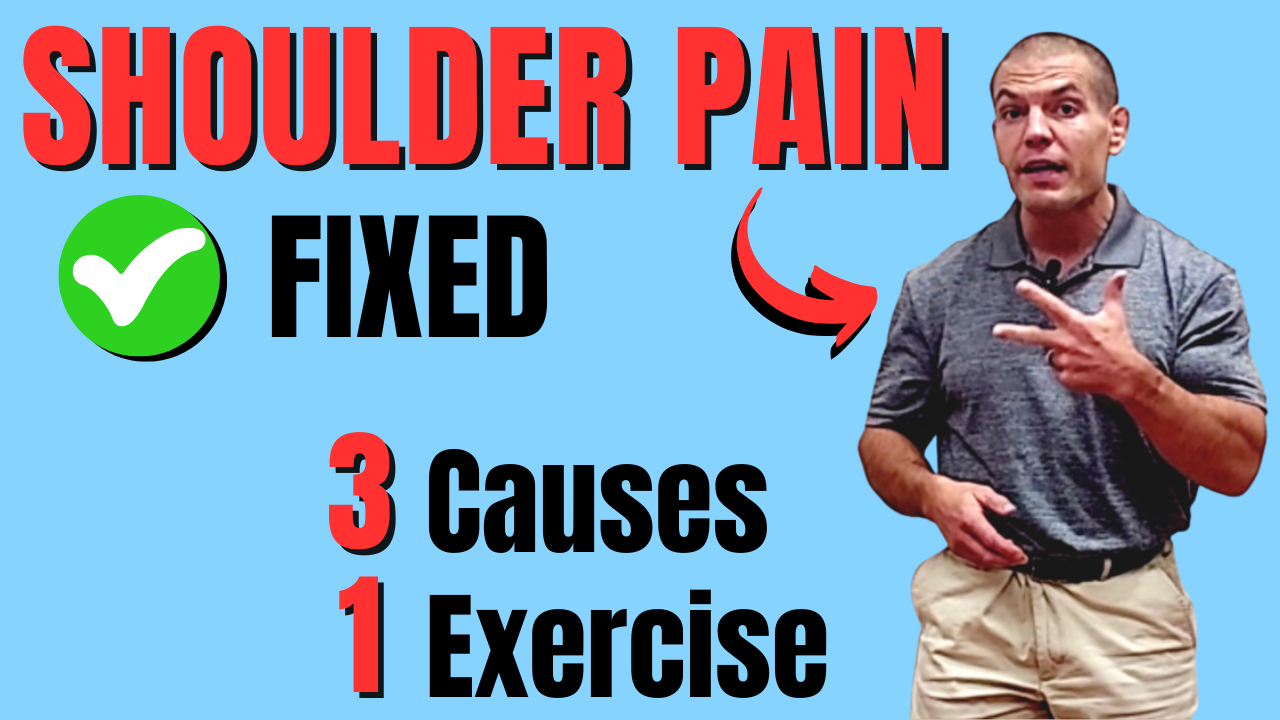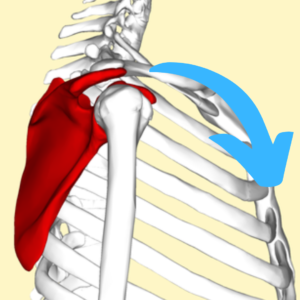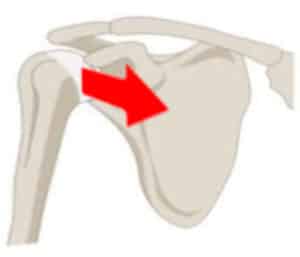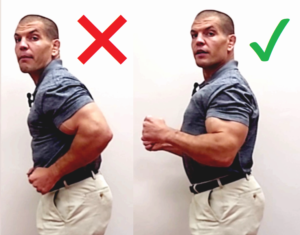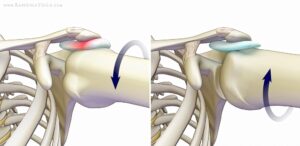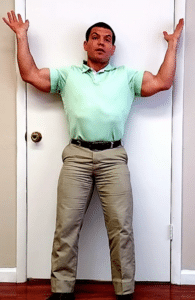There are three really common causes of shoulder pain. The good news is that they're all easy to fix IF you know what they are, and IF you pay attention to them.
Watch the video to learn the three most common causes of shoulder pain and how to fix them. Plus, at the end, you'll learn ONE great exercise that addresses all three of those causes.

Structural Causes Of Shoulder Pain
If you want to know the top 3 anatomical causes of shoulder pain, numbers one, two, and three would probably all be some type of rotator cuff problem.
Between rotator cuff tendonitis, rotator cuff tendinopathy, and rotator cuff tears, rotator cuff problems make up 70 to 90 percent of all shoulder pain cases.
So if you have shoulder pain, there's a good chance you have some sort of rotator cuff problem.
But just knowing that you have a rotator cuff problem doesn't really get you any closer to treating it.
In this post, I'm going to discuss the 3 three causes of rotator cuff problems which actually give you some control, because they're things that you can fix directly.
3 Functional Causes Of Shoulder Pain
Most rotator cuff problems are caused by some type of shoulder impingement.
Shoulder impingement means that the rotator cuff tendons are getting pinched between the ball of the shoulder and the arch that runs over the socket of the shoulder.
But there are several causes of shoulder impingement syndrome itself. Here are the three most common ones.
Shoulder Pain Cause #1: Forward Tilted Shoulder Blades
We all spend a lot of time sitting in the modern world, either sitting at computers, looking down at our phones, and driving. Chances are good that you're sitting down right now while reading this.
But if you sit a lot of the time with your shoulders rounded and tilted forwards, that brings an arch of bone called the acromion process down into the space where your rotator cuff tendons run.
Thus you can pinch, irritate, or even tear your rotator cuff tendons over time.
When people try to correct this problem, often the focus is on pulling their shoulder blades back and squeezing your shoulder blades together.
This is common advice that people may find online, hear from family or friends, or be told by a physical therapist.
However, squeezing your shoulder blades back together doesn't fix the primary cause of shoulder pain.
That's because it's more the forward tilt of the shoulder blades rather than the side to side rounding that is responsible for pinching the rotator cuff tendons.
How To Fix Shoulder Pain Caused By Forward Tipping Of The Shoulder Blades
Rather than thinking about squeezing your shoulder blades back, think about lifting your chest up.
When you lift your chest up and extend through your upper back, it naturally tilts your shoulder blades backward.
You don't really have to think about squeezing your shoulder blades back together.
In fact, sometimes squeezing your shoulder blades together can actually cause a forward tipping of your shoulders. That's especially true if you're squeezing your shoulders by pulling your elbows back as if doing a row.
Extending your elbow behind the plane of your body causes a lot of extension at the shoulder joint.
Because of the way the ball and socket joint works mechanically when your elbow goes backward, the ball of yor shouler glides forward into the socket.
This brings us to the second cause of shoulder pain, which is anterior (forward) glide of the shoulder.
Shoulder Pain Cause #2: Anterior Glide Syndrome
When the ball of the shoulder glides too far forward in the socket it can start to cause pinching in the rotator cuff tendons.
That particularly true when you do things like reach above your head or reach across your body.
If you get shoulder pain when you're reaching overhead or reaching across your body, there's a good chance that you may have a forward glide of the shoulder.
So how do you fix that?
How To Fix Shoulder Pain Caused By Anterior Glide Syndrome
First, you want to avoid positions where your elbows go really far back behind your body.
For example if you're doing a rows (a common physical therapy exercise for shoulder pain), you don't want to allow your shoulder blades to tip forward.
Just pull your shoulders to your sides and squeeze your shoulder blades. However, don't let your elbows come behind the plane of your body.
That might be avoiding reaching back for things behind you such reaching in the back seat of a car.
Another common stretch that people do for shoulder pain is they'll stretch their chest muscles incorrectly. On common way people do this is stretching in a doorway.
In general stretching your chest, muscles is good for shoulder pain. However, if you allow your elbow to go too far behind you when stretching your chest muscles, then it can cause a forward glide of the shoulder. A common example would be leaning too far into the doorway when doing the exercise above.
Learn how to stretch your chest muscles correctly.
In general, a good rule of thumb is to keep your elbows in line with your body or slightly in front of your body. This will help prevent forward glide of the shoulder as well as forward tipping of the shoulder blade.
In facts, the first 2 causes of shoulder pain are highly interlinked.
So if you think about 1) chest up and 2) two elbows at or slightly in front of the plane of the body, that's will help fix the first 2 causes of shoulder pain.
Shoulder Pain Cause #3: Excessive Internal Rotation
Problem number three is internal rotation of the shoulders.
Your shoulder is like a ball and socket joint, but that's not a perfectly round ball. The ball has little bumps on it to which your rotator cuff muscles attach.
Depending on which way you rotate the ball in the socket, it brings one of those bumps underneath the arch of the shoulder.
Image source: bandhayoga.com
That can pinch your rotator cuff and cause shoulder pain.
How does this happen in the real world?
If you lift your arm above shoulder level something with your thumb pointed inward or downward, that causes internal rotation of the shoulder.
Examples include:
- reaching for something in the refrigerator
- reaching for clothes hanging in the closet
- reaching for a dish on a high shelf of a cupboard
How To Fix Shoulder Pain From Excessive Internal Rotation
So if you have trouble reaching for things above head, one tip to think about is keeping your elbow in and/or keeping your thumb up.
Doing this will make reaching above head much easier.
If you have to grab a dish off of a high shelf in a cabinet, you may have to grasp it with your thumb down. However, you can still reach up with your elbow in and thumb up. Then rotate your forearm before grasping without allowing your elbow to flare out to the side.
Summary Of Shoulder Pain Causes
So those were the three most common causes of shoulder pain. Again, structurally most shoulder pain is due to some type of rotator cuff problem. However, keeping your chest up, keeping your elbow in front of your body, and preventing your elbow from flaring out to the side when reaching can substantially relieve your shoulder pain.
Bust what about the exercise?
ONE Exercise To Fix 3 Causes Of Shoulder Pain
In truth, the exercise isn't as important as the postural and functional changes noted above. Those will get you far more bang for your buck than doing exercises for a few minutes per day.
However, one great exercise is to stand with your lower back pressed flat against the wall.
Your upper back may or may not touch, and that's okay.
Your thoracic spine should be rounded a little bit forward, and so it's normal not to have your shoulders all the way back on the wall.
So get your lower back flat, and then think about lifting your chest as much as you can without letting your lower back arch so that your lower back leave the wall.
This helps with problem number one, the forward tipping of the shoulder.
Next, bring your elbows in front of you, which addresses problem number two.
Then externally rotate your shoulders which addresses problem number three.
Now you're going to bring your elbows back towards the wall but not behind the plane of your body.
Make sure to keep your arms externally rotated by turning the back of your palms towards the wall.
Again, make sure your lower back stays flat on the wall.
The raise your arms far upward as you can while still keeping your chest up, elbows forward, and wrists back.
If you start to have pain at any point in this process, just stop where you are and hold that position.
Hold the exercise in a comfortably position for 10 seconds. And then after you've held for 10 seconds, then bring your arms back down and repeat 10 times.
If you can't do that many to start, that's okay. Just start from where you're able to and work your way up over time.
Again don't cause yourself any additional pain while doing the exercise. The exercise should feel difficult, but it shouldn't be painful.
Conclusion
Hopefully you now understand the causes of shoulder pain and how to fix them. Again, most shoulder pain cases are rotator cuff problems. However, just knowing that doesn't help you treat your shoulder pain.
However, if you avoid excessive forward shoulder tipping, forward glide of the ball of the shoulder, and excessive shoulder internal rotation, you can help relieve shoulder pain.
Additionally, doing the back to walk stretch shown above can help all 3 of these causes of shoulder pain.
Need Help For Shoulder Pain?
If you live in the St. Louis area and need help for shoulder pain, we'd be happy to help you here at More For Life. Just tap the button below to request and appointment with one of our specialists.
Like this post? Here are some other posts about shoulder pain that you might enjoy:
Can I Exercise With Rotator Cuff Injury?
8 Exercises For Rotator Cuff Strengthening Plus Common Mistakes To Avoid
How Do I Know If I Need Shoulder Surgery For A Rotator Cuff Tear?

